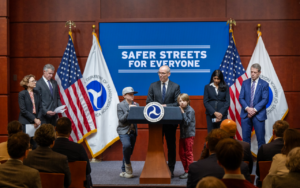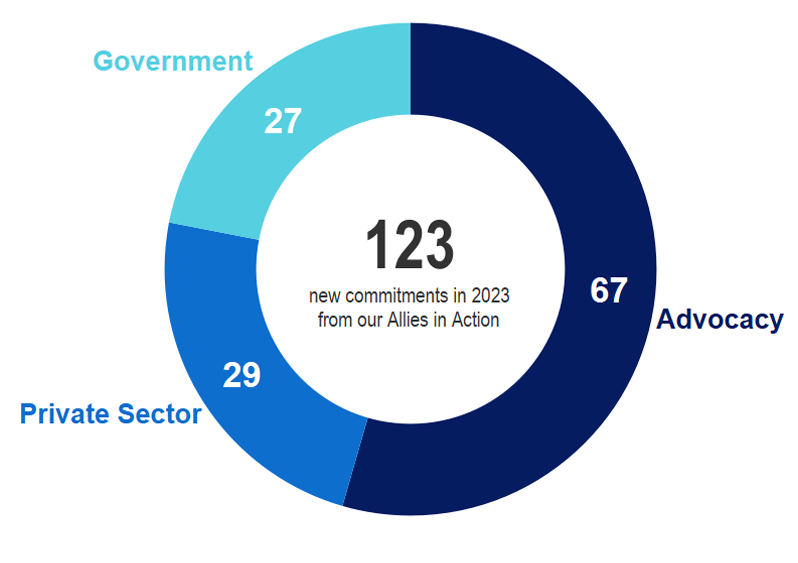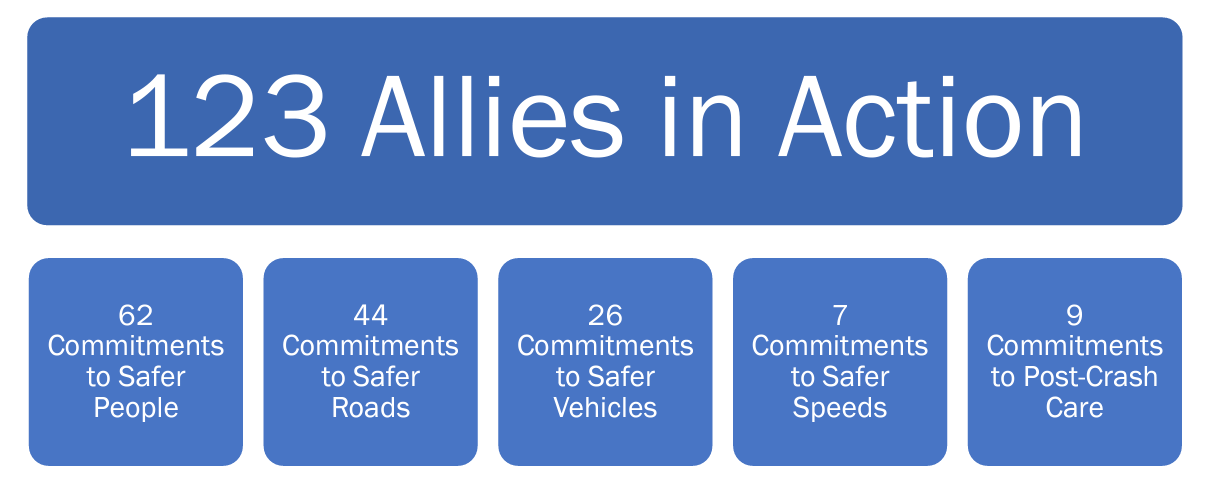
USDOT shares safer roads strategy update, plan to improve automated driving
By onAnnouncements
The U.S. Department of Transportation (USDOT) has released its 2024 National Roadway Safety Strategy Progress Report (NRSS), which highlights key steps taken last year by the department and safety partners to improve road safety and decrease fatalities.
NRSS was launched in January 2022 after nearly 43,000 died in roadway-related incidents in 2021. That was the highest number of fatalities since 2005, according to the report.
Fatalities have been steadily rising since 2010 before surging in 2020. The last six quarters have shown small decreases in traffic fatalities, according to preliminary data through September 2023 from the National Highway Traffic Safety Administration (NHTSA). Early estimates for the first nine months of 2023 show a continued decline in fatalities of about 4.5% compared to the first nine months of 2022, according to the USDOT report.
The NRSS lays out a set of actions USDOT has committed to via a five-pronged approach:
-
- Safer people
- Safer vehicles
- Safer speeds
- Safer road
- Better post-crash care
The progress report includes a list of actions taken last year that USDOT says are accomplishments in addressing the NRSS. The most significant actions, according to USDOT were:
-
- Awarded $1.7 billion in funding to improve roadway safety at the local, regional, and Tribal levels through the “Safe Streets and Roads for All” discretionary grant program. More than 1,000 communities received funding, representing close to 70% of all Americans;
- Accelerated the deployment of new motor vehicle safety technologies through rulemakings for automatic emergency braking (AEB) on all new passenger vehicles and heavy vehicles including commercial trucks;
- Initiated an advance notice of proposed rulemaking for impaired-driving prevention technology standards;
- Updated key road safety regulations such as the new edition of the “Manual on Uniform Traffic Control Devices,” and revised guidance to encourage states to use federal aid funds for repaving and rehabilitation projects to improve safety for road users; and
- Expanded the use and support of the National Emergency Medical Services Information System by accepting data from all 50 states, two territories, and the District of Columbia.
Last year, 123 businesses and organizations signed on to support the NRSS and take action to reverse the crisis on America’s roads, bringing the total number of “Allies in Action” to 160, USDOT said.
Allies have committed to taking specific, tangible steps to actively reduce the number of deaths and serious injuries on America’s roads and streets, expand the adoption of a “Safe System Approach” and a “Zero Fatalities” vision across the nation, and transform how we as a nation think about road safety.
Thirty-six of the new allies are state and territory transportation agencies and highway safety offices.
The transportation agencies and highway safety offices plan to:
-
- Implement proven safety countermeasures;
- Complete street policies and plans;
- Revisit policies around speed-setting;
- Advance infrastructure improvements for vulnerable road users;
- Engage stakeholders to identify community highway safety concerns and solicit input on potential solutions;
- Pursue cutting-edge data analytics that uses historical crash data, enforcement data, and various third-party, real-time data; and
- Pursue outreach and education efforts related to speed management and rural-high-risk road safety improvement projects.
Several states have also discussed a commitment to work zone and rural road safety enhancements as well as emergency notifications to alert roadway users of major incidents and weather, USDOT said.
States and territories that have made a commitment or are in the last stage of finalizing their commitment include Alaska, Arizona, Arkansas, California, Connecticut, Delaware, District of Columbia, Georgia, Hawaii, Illinois, Kansas, Kentucky, Maryland, Massachusetts, Michigan, Minnesota, Mississippi, Missouri, Montana, Nebraska, New Jersey, New York, New Mexico, North Carolina, Ohio, Oklahoma, Oregon, Pennsylvania, Puerto Rico, Rhode Island, Utah, Virginia, Washington, West Virginia, Wisconsin, and Wyoming.
The full list of allies can be viewed here.
USDOT announced $1.25 billion in funding Wednesday that’s available for the next round of its “Safe Streets and Roads for All” discretionary grant program. The competitive grants help cities, counties, Tribes, and metropolitan planning organizations create safety plans, demonstrate effective strategies, and implement safety projects that prevent deaths and serious injuries on our nation’s roadways, according to USDOT.
“America still loses tens of thousands of lives on our roads every year and we must do more,” said U.S. Transportation Secretary Pete Buttigieg, in a news release. “The updates we’re announcing… show that progress is possible, and we continue our call to action for all Americans to join with us and the partners who have already stepped up to save lives on our roadways.”
In a letter included in the 2024 progress report, Buttigieg wrote, “The proportions of our roadway safety crisis are such that even a one percent reduction in crash deaths in one year represents the equivalent of preventing two or three fatal airliner crashes. Each percent reduction also represents a step toward our stated goal of zero. We are making progress and must make more.”
U.S. Transportation Deputy Secretary Polly Trottenberg added, “The Department won’t achieve zero deaths on our roadways alone, which is why involving stakeholders across the country at every level of government, philanthropy, advocacy, and the private sector, is key. The National Roadway Safety Strategy is driving a cultural shift that treats roadway deaths as unacceptable and preventable. We have an incredible opportunity with President Biden’s Bipartisan Infrastructure Law, which allows us to make a generational investment in America’s transportation network.”
A new NRSS action USDOT plans to take beginning this year is automated driving system (ADS) safety improvements.
USDOT shared in the report that it will propose regulatory amendments regarding ADS-equipped commercial motor vehicles to prioritize safety and security, including updates to CMV operations, inspection, repair, and maintenance regulations. It will also work with partners bilaterally and at the United Nations to develop guidance and international standards, as appropriate, for the safety of motor vehicles equipped with automated driving systems, USDOT said.
Beyond Lucid Technologies (BLT) has become an ally to work with fleet operators, beginning with ambulance and fire services, to ensure when a crash occurs, the first responders have key clinical context about vehicle occupants and can provide the most informed care possible, USDOT said.
The company’s HALCYON Post-Crash Intelligence platform is being piloted in two states. It provides the number of people involved in the crash and their critical health contexts. BLT plans to begin using the platform in other states by mid-year.
Two automakers, Ford and Stellantis, have also become allies.
In 2024, Ford will enhance the programming it offers through its Ford Fund to include discussions about vulnerable road user safety, outreach to teen drivers without access to driving resources and training, and outreach to stakeholders around Safe Systems Approach philosophies and messaging.
The Ford Fund provides grant funding to nonprofit organizations that address roadway safety with a special emphasis on programs that promote safer conditions for vulnerable road users. In December, the Ford Fund announced a $5 million investment in mobility solutions focused on addressing transportation insecurity in Ford’s hometown communities in Southeastern Michigan, Louisville, Kansas City, Chicago, Ohio, West Tennessee, and Buffalo.
Stellantis shared with USDOT that it will share vehicle safety recall information through public awareness campaigns and by taking steps to raise the repair rate for vehicles with open recalls, especially among underserved communities where repair rates are disproportionately lower including communities of color, Tribal Nations, rural areas, low-income populations, and military families.
Throughout this year, Stellantis will conduct media buys in high-risk communities, triple door-to-door canvassing staff to 150, expand canvassing from 29 to more than 70 metro markets, provide all U.S. military branches with digital and physical marketing content for distribution to service members, and offer tribal safety professionals digital and physical safety materials to share with their communities.
The National Center for Rural Road Safety will connect with and train rural practitioners across the country with its “Road Safety Champion Program,” a Safety 101 certificate training for transportation, public health, and law enforcement staff who have an interest in roadway safety but are not safety experts.
The center will also promote rural traffic safety culture through its annual “Rural Road Safety Awareness Week,” and connect rural and tribal practitioners with the resources and federal funding they need to implement the “Safe System Approach” to get to “Zero Fatalities and Serious Injuries.”
Images
Daniel Langenkamp, founder of the Sarah Debbink Langenkamp Bike Safety Memorial Fund, with sons Oliver (left) and Axel (right), speaks at USDOT’s Feb. 21, 2024 National Roadway Safety Strategy event about the tragic death of his wife Sarah last year while riding her bicycle. (From left to right) U.S. Deputy Secretary of Transportation Polly Trottenberg, AASHTO Executive Director Jim Tymon, Maryland Lt. Gov. Aruna Miller, and Nebraska Gov. Jim Pillen also gave remarks. (Credit: USDOT)
Chart and graph provided in 2024 NRSS progress report (Credit: USDOT)


